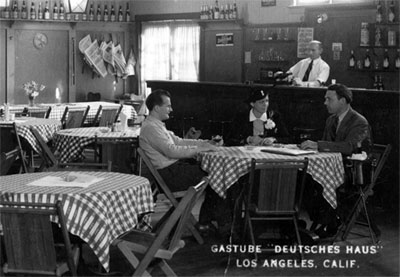Historical Context
The Great Depression and the World Wars were the major historical influences on Americans between 1933 and 1945. The 1929 stock market crash had left 13 million people unemployed and 2 million homeless. A documentary of the period would have revealed Hoovervilles, dust storms, labor union strikes, violent farmers protesting foreclosures and unarmed WWI Vets marching on the White House for their promised bonuses, only to be met by U.S. Army tanks.
In 1933 Adolf Hitler became the head of Germany's Third Reich and Franklin Delano Roosevelt entered the Oval Office. In the United States, the New Deal brought hope for recovery. In Germany, Jews and other victims were being beaten in the streets. Many Americans were scared and vulnerable. In the battle of ideologies that followed, it was only a short leap from the logical questioning of the viability of democracy to the illogical blaming of an entire race for the world's economic and political problems.

The Nazi Propaganda period, 1933 to 1945, chronicles a crucial twelve years in American history. This exhibit's story about the local threat to American ideals demonstrates how European events reached across the ocean and affected people in Southern California -- in our own backyard. It is the story of the exploitative behavior that resulted from distorted beliefs.
The approximately 200 items in this exhibit focus on the clashing ideologies of this era and the activities of the various groups that embraced them. The original books, pamphlets, flyers, newspapers, letters and photographs reflect the profusion of media barraging the public as it searched for answers in a period of turmoil.
The first section of the exhibits sets the scene. Hitler used the scapegoat tactic to inspire the German masses to assume their rightful place in world affairs. Designating a scapegoat gave him someone to blame and enabled him to divide and conquer. His aim was to divide Americans into two nations, Christian and Jew, and then to make a psychological connection between the words "Jew," "Bolshevik" and "Communist" in the American mind. Symbolic pictures and words set the Jews apart as a race to fear and hate.
Kenneth M. Gould, in his booklet, They Got the Blame, explains:
Propaganda is a great deal more than persuading people to believe something that isn't true; it is a technique that works below the surface of the mind, warping men's emotions with fantasies and fears, diverging their thinking toward economic conflicts, political dissention, religious prejudice, until the nation as a whole disintegrated....
In 1934 the Los Angeles Jewish Community Committee organized to expose pro-Nazi and anti-Semitic activities. It worked steadily toward those aims, mainly through the use of undercover spies, until the United States entered the war in December, 1941. At that time the Committee changed its name and its focus. The new Community Relations Committee became even more active and expanded its efforts to combat bigotry and to promote tolerance through speakers and published materials.
The mid portion of the exhibit focuses on the growing numbers of native ideological movements and the need for the public's increased awareness about their true -- as opposed to their professed -- intent. The German-American Bund, the Ku Klux Klan, The Militant Christian Patriots, William Dudley Pelley's Silvershirts and Father Charles Coughlin's Christian Front were influenced by Nazi, Fascist, and anti-Semitic ideology. It became necessary to question their members' allegiance and motives. For example, there were sincere people who were opposed to war of any kind, and there were those who only wanted to keep the United States from hindering Hitler. Was their allegiance to the United States, to Germany or only to themselves? The Aryan Book Store in Los Angeles sold and published a profusion of Nazi propaganda materials.
Rallies and picnics were held at Hindenberg Park in La Crescenta. The American boycott of German goods was twisted into a boycott of Jews.

During this era, the Hollywood movie industry was accused of being a Jewish-controlled corruptive influence on American Youth and of depriving deserving white Americans of employment. Hollywood responded through the publications and activities of the Hollywood Anti-Nazi League for the Defense of American Democracy, and through individual actors who used their influence to speak publicly against Nazism and intolerance.
The exhibit concludes with America's attempt to define disloyalty and the limits of free speech. Through the Dies Committee investigations, the introduction of prohibitive bills in Congress, and finally, through the attempt to prosecute those accused of un-American activities in the Sedition Trial of 1944, Americans tried, but failed, to form conclusive answers.
President Roosevelt's words from his final 1940 campaign speech are relevant today:
We Americans. . .are characters in the living book of democracy. But we are also its author. It falls upon us now to say whether the chapters…to come will tell a story of retreat or. . .of continued advance.
This exhibit relates the story of the threat in Southern California in the 1930's and 40's, and serves as a warning that such dangers still exist in American life.